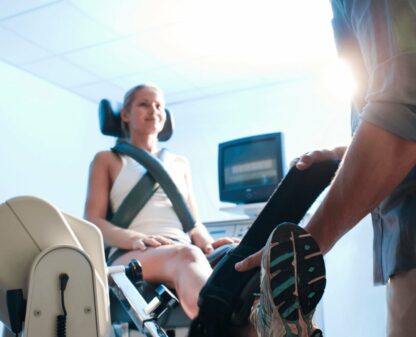Activity Modification and Strength Training for Osgood Schlatter's Disease

Introduction
Osgood-Schlatter disease (OSD) is a growth-related apophysitis of the knee, affecting 1 in 10 athletic adolescents. Early specialization in sports is associated with a fourfold greater risk of developing OSD. Sixty percent of patients diagnosed with OSD reported pain at a median of 4 years’ follow-up.
Currently, no research existed on active management strategies for this condition. This prospective cohort study is the first to test activity modification and strength training for OSD.
Methods
Patients were recruited via social media and several schools according to the following inclusion criteria:
Inclusion criteria:
- Pain localized at the tibial tuberosity that increased with palpation
- Pain on resisted isometric knee extension
Exclusion criteria:
- Knee effusion
- Patellar instability
- Sinding-Larsen-Johansson syndrome
- Concomitant injury or pain in the hip, lumbar spine, or other structures of the knee (ie, tendinopathy, previous knee surgery, or patellofemoral pain)
Note that no radiographs were needed for inclusion
Outcomes
Since this is the first trial in the field, no a priori power calculation was possible. The primary outcome measure was the global reporting of change at 12 weeks by the adolescents. Several other outcome measures were registered but we will not get much into those since these were exploratory.
Exercise intervention
The intervention consisted of four visits with a physical therapist over 12 weeks.
The first four weeks started with a temporary reduction in sport participation and aggravating activities. To counter possible strength loss, exercises were provided:

Weeks 5-12:

The program was as follows:

Information booklet
Apart from these exercises, the participants were provided with a detailed booklet on OSD with clear figures for activity progression and key things to do after five weeks.
If you are interested in seeing the complete booklet: Download
Results
The adolescents suffered — on average — 21 months with OSD symptoms. After providing the intervention, 80% reported a successful outcome. Success was achieved if participants reported being ‘improved’ or ‘much improved’ on a 7-point Likert scale with ‘no change’ in the middle. Although this sounds pretty good, about half of the youngsters still complained of knee pain after twelve weeks and one year. After 12 months, 69% returned to sport, however, many of them with lower weekly volume.
Talk Nerdy to Me
First of all, we should applaud the authors for being the first ones to research active management strategies for OSD. Since there is no previous research in the field, a power calculation could not be made. A great pro about this study is the fact that it is preregistered. Meaning that the complete research plan was published before the results were known. This may not sound as much but this ensures that the researchers are —in fact — investigating the thing they wanted to. Without this, one can make alterations, hypothesize something different, or keep looking for other ‘significant’ measures to ‘prove’ something.
You guys probably noticed that there is no control group in this study. This is often the case in trials that look into something completely new. Why invest in a control group, and a bigger study, when you don’t even know if your hypothesis is reasonable to assume? That said, it does happen as a first trial, and eventually, the researchers should do an RCT when there seem to be interesting effects.
Keeping the aforementioned in mind, we do not know if the effects are due to contextual effects, placebo, etc. Or maybe the youngsters just got more confident in their knee, making them seem ‘stronger’, and making them move more which results in a decrease in symptoms. This is rather speculative, a bigger study with a control group might provide some answers.
The results of this study are promising. However, as you have read, knee pain is not resolved for everyone. Can we assume that we one day will be able to? I don’t know. What it does show, is that ongoing management might be indicated.
Let’s talk about the exercises. ‘Strengthening’ is what they are doing they say — and they are quite right since quadriceps strength increased by about 30% for the adolescents. However, if such a program will provide sufficient strength-gains further down the line is questionable. Eventually, bodyweight exercises with such intensity won’t do the trick. Specific quad work was included in the first four weeks (isometric knee extensions), but this was replaced by compound exercises afterward. What if they progressed to a weighted leg extension? Probably less accessible at home so practically speaking this might not be easy but from a theoretical standpoint — could it be sufficient?
That is one of many questions that such a research study encourages. We hope to see much more in the coming years.
Take Home Messages
- Load management and exercises might be a useful option in OSD
- Lots unknown and lots to learn from this disease
Reference
LEARN TO OPTIMIZE REHAB & RTS DECISION MAKING AFTER ACL RECONSTRUCTION
Sign up for this FREE webinar and top leading expert in ACL rehab Bart Dingenen will show you exactly how you can do better in ACL rehab and return to sport decision making



